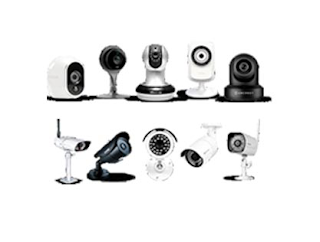Types of Security Cameras
The simplest way to think about the types of security cameras is to break them down into two groups: indoor cameras and outdoor cameras. While each of these groups have different styles of cameras within them, those differences will become apparent when you compare features, so separating them further isn’t necessary. For instance, none of the cameras we talk about in this guide are dome cameras, not because dome cameras are of lower quality, but because they simply aren’t necessary for most home security camera systems.
Both types of security cameras are available as stand-alone units with monitoring apps or as part of subscription-based home security monitoring systems. In this guide, we compare the top indoor and outdoor security cameras as well as the combinations of cameras available through the top subscription monitoring services.
Important Security Camera Features
Below are some of the important features to keep in mind when comparing home security cameras.
Motion Detection
Cameras with motion detection can send you notifications when the camera observes motion within its field of view. These notifications can alert you to suspicious activity so you can monitor the situation.
Field of View
Field of view refers to how wide an angle a camera can record. This is important because it will affect how many cameras you’ll need and where you should place them.
Sound
The sound feature can refer to your camera receiving sound via a microphone, emitting sound via a speaker, or both. Cameras with both can double as intercoms.
Resolution
Resolution defines how clear the image from your camera will be. A clearly visible image is very helpful when trying to identify faces or items in the images your camera records.
Wi-Fi Capability
A camera with Wi-Fi can communicate with your home network wirelessly, which can be very handy for installation, and is also less susceptible to being disabled because it doesn’t have wires that could be cut.
The simplest way to think about the types of security cameras is to break them down into two groups: indoor cameras and outdoor cameras. While each of these groups have different styles of cameras within them, those differences will become apparent when you compare features, so separating them further isn’t necessary. For instance, none of the cameras we talk about in this guide are dome cameras, not because dome cameras are of lower quality, but because they simply aren’t necessary for most home security camera systems.
Both types of security cameras are available as stand-alone units with monitoring apps or as part of subscription-based home security monitoring systems. In this guide, we compare the top indoor and outdoor security cameras as well as the combinations of cameras available through the top subscription monitoring services.
Important Security Camera Features
Below are some of the important features to keep in mind when comparing home security cameras.
Motion Detection
Cameras with motion detection can send you notifications when the camera observes motion within its field of view. These notifications can alert you to suspicious activity so you can monitor the situation.
Field of View
Field of view refers to how wide an angle a camera can record. This is important because it will affect how many cameras you’ll need and where you should place them.
Sound
The sound feature can refer to your camera receiving sound via a microphone, emitting sound via a speaker, or both. Cameras with both can double as intercoms.
Resolution
Resolution defines how clear the image from your camera will be. A clearly visible image is very helpful when trying to identify faces or items in the images your camera records.
Wi-Fi Capability
A camera with Wi-Fi can communicate with your home network wirelessly, which can be very handy for installation, and is also less susceptible to being disabled because it doesn’t have wires that could be cut.

